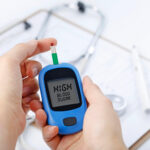
In this article
Odynophagia is the medical term for pain or discomfort when swallowing. This pain can be felt as a burning or squeezing sensation anywhere from the throat or neck down to the sternum (breastbone).
Conditions that cause inflammation, irritation, or damage to the throat, mouth, or esophagus (food pipe) can lead to odynophagia. Sometimes, odynophagia is a temporary issue caused by infections. However, persistent odynophagia may indicate an underlying condition such as gastroesophageal reflux disease (GERD) or eosinophilic esophagitis (EoE).
Treatment for odynophagia varies depending on the cause and may include lifestyle modifications, medications, or surgery.
What Does Odynophagia Feel Like?
The sensation of odynophagia varies among individuals. Generally, it starts when swallowing food or liquid and ends when the swallowing process is complete. Pain can be felt in the back of the mouth, throat, or chest, and may range from mild discomfort to severe pain, affecting one or both sides of the throat.
Common sensations associated with odynophagia include:
- Burning in the throat or chest
- Throat tightness
- Squeezing in the chest or throat
- Pressure or heaviness in the neck or chest
Odynophagia often occurs with other symptoms such as:
- Dysphagia (difficulty swallowing)
- Chest pain unrelated to swallowing
- Regurgitation
- Feeling of a lump in the throat
- Weight loss
- Heartburn
- Nausea or vomiting
- Hoarseness
- Persistent cough
- Fever
Causes of Odynophagia
Odynophagia can result from both acute and chronic conditions that irritate, inflame, or damage the mouth, throat, esophagus, or neck tissues.
Infections
Infections are a common cause of odynophagia. Viral, bacterial, and fungal infections can cause inflammation and irritation in the throat structures, including the esophagus (food pipe), trachea (windpipe), and tonsils.
- Viral infections: Common cold, influenza (flu), COVID-19, and cytomegalovirus (CMV) can lead to odynophagia. Symptoms may include a runny nose, fatigue, cough, and body aches.
- Bacterial infections: Streptococcal pharyngitis (strep throat) can cause intense pain when swallowing, often with red, swollen tonsils, fever, chills, and swollen neck lymph nodes.
- Fungal infections: Oral thrush, caused by the yeast Candida albicans, can lead to painful swallowing, white patches on the tongue and mouth, and bleeding when brushing teeth.
Gastroesophageal Reflux Disease (GERD)
GERD occurs when stomach acid flows back into the esophagus, irritating its lining. Repeated acid reflux causes inflammation and can lead to painful swallowing, heartburn, a sour or bitter taste in the mouth, nausea, hoarseness, chronic cough, and regurgitation.
Untreated GERD can cause esophageal ulcers, making swallowing more painful. Risk factors for GERD include smoking, alcohol consumption, lying down shortly after eating, obesity, scleroderma, and hiatal hernia.
Eosinophilic Esophagitis (EoE)
EoE is a chronic allergic inflammatory condition where eosinophils, specialized white blood cells, accumulate in the esophagus in response to allergens. This leads to inflammation, causing painful swallowing, difficulty swallowing, heartburn, and chest pain. EoE is more common in individuals with other allergic diseases like asthma, eczema, seasonal allergies, and food allergies.
Medication-Induced Esophagitis
Certain medications can irritate and inflame the esophagus if not taken with enough water or if taken right before lying down. This can lead to odynophagia, chest pain, and back pain. Medications commonly associated with this condition include antibiotics, non-steroidal anti-inflammatory drugs (NSAIDs), and bisphosphonates.
Esophageal Cancer
Esophageal cancer occurs when abnormal cells multiply and form a tumor in the esophagus. Odynophagia occurs when the tumor interferes with normal swallowing. Other symptoms include pain behind the breastbone, difficulty swallowing, hoarseness, chronic cough, and unintended weight loss. Risk factors include heavy alcohol use, smoking, and Barrett’s esophagus, with the risk increasing with age.
Nutcracker Esophagus (Hypercontractile Esophagus)
Nutcracker esophagus is a motility disorder causing excessively forceful esophageal contractions during swallowing, leading to severe odynophagia, chest pain, and difficulty swallowing. The exact causes are not fully understood but may involve abnormal nerve signaling between the brain and esophageal muscles.
Less Common Causes
Other causes of odynophagia include:
- Achalasia: A rare motility disorder where nerve damage in the esophagus hinders the movement of food toward the stomach.
- Injury: Swallowing harmful substances like bones or acidic substances, or radiation therapy to the head or neck can damage esophageal tissues.
- Esophageal stricture: Narrowing of the esophagus due to GERD, eosinophilic esophagitis, injury, or long-term use of a nasogastric tube.
- Autoimmune conditions: Disorders like rheumatoid arthritis, Crohn’s disease, connective tissue disorders, systemic sclerosis, and scleroderma can affect the esophagus and cause odynophagia.
When to See a Healthcare Provider
Odynophagia from viral infections typically resolves within a few days. However, it’s important to see a healthcare provider for persistent or severe pain when swallowing or if you experience odynophagia with symptoms such as:
- Abdominal pain
- Cough
- Fever
- Chills
- Nausea or vomiting
- Wheezing
- Sour or bitter taste in the mouth
Seek prompt medical attention for odynophagia accompanied by:
- Bloody or black stools
- Shortness of breath
- Lightheadedness
- Weight loss
A healthcare provider will perform a physical examination, ask about your symptoms, and may order diagnostic tests like an endoscopy or esophagram to determine the underlying cause of odynophagia.
Treatments for Odynophagia
The goal of treatment is to manage and reduce pain while addressing the underlying cause.
Home Remedies
Home remedies and adjustments to eating habits may help ease painful swallowing:
- Hydrate: Drink plenty of fluids to soothe an irritated throat.
- Gargle with warm salt water: Reduce throat inflammation and relieve pain.
- Eat slowly: Take small bites and chew thoroughly before swallowing.
- Consume soft foods: Soft or liquid foods like pudding, soups, and smoothies can be easier to swallow.
Medications
Your healthcare provider may prescribe medications to manage odynophagia and its underlying cause:
- Analgesics: Over-the-counter pain relievers like Tylenol (acetaminophen) and Advil (ibuprofen) can provide temporary relief.
- Antacids and acid suppressants: Reduce acid reflux and associated pain in GERD-related odynophagia.
- Antibiotics, antivirals, or antifungals: Treat bacterial, viral, or fungal infections causing odynophagia.
Surgery
In severe or persistent cases, surgery may be necessary:
- Fundoplication: A procedure for GERD-related odynophagia that strengthens the lower esophageal sphincter to reduce acid reflux.
- Esophageal dilation: Stretches narrowed areas of the esophagus to relieve pain and difficulty swallowing.
Prevention
While it’s not always possible to prevent odynophagia, certain lifestyle habits can lower your risk:
- Avoid smoking: Smoking can irritate the esophagus and increase the risk of GERD and esophageal cancer.
- Manage acid reflux: Follow treatment plans for GERD, avoid eating late at night, and eat smaller, frequent meals.
- Safe medication use: Swallow medications with plenty of water and avoid lying down immediately after taking them.
- Avoid allergens: If you have food or environmental allergies, avoid known triggers to prevent eosinophilic esophagitis.
- Dietary habits: Avoid spicy, acidic, or hot foods that can irritate the esophagus. Eat slowly and chew thoroughly.
Complications
Persistent or severe odynophagia should be evaluated by a healthcare provider. Untreated odynophagia and its underlying cause can lead to complications, such as unintended weight loss, nutritional deficiencies, malnutrition, and dehydration from avoiding eating and drinking due to discomfort
A Quick Review
Odynophagia, or pain when swallowing, can result from various conditions such as infections, GERD, eosinophilic esophagitis, and more. Symptoms include burning, throat tightness, and chest pain. Treatment depends on the underlying cause and may include lifestyle changes, medications, and surgery
FAQS
What are common causes of odynophagia?
Common causes include infections (viral, bacterial, fungal), GERD, eosinophilic esophagitis, medication-induced esophagitis, and esophageal cancer.
How is odynophagia treated?
Treatment varies depending on the cause and may include home remedies, medications, and in severe cases, surgery.
Can odynophagia be prevented?
While not always preventable, lifestyle habits like avoiding smoking, managing acid reflux, and avoiding allergens can lower your risk.
What are the symptoms of odynophagia?
Symptoms include burning in the throat or chest, throat tightness, squeezing sensations, and pressure in the neck or chest, often accompanied by other symptoms like heartburn and regurgitation











